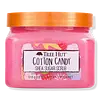What's inside
What's inside
 Key Ingredients
Key Ingredients

 Benefits
Benefits

No benefits
 Concerns
Concerns

 Ingredients Side-by-side
Ingredients Side-by-side

Sucrose
HumectantGlycerin
HumectantPolysorbate 20
EmulsifyingSilica
AbrasiveFragaria Vesca Fruit Extract
AstringentPersea Gratissima Oil
Skin ConditioningButyrospermum Parkii Butter
Skin ConditioningCarthamus Tinctorius Flower
MaskingPrunus Amygdalus Dulcis Oil
Skin ConditioningOenothera Biennis Oil
EmollientMacadamia Ternifolia Seed Oil
EmollientCitrus Aurantium Dulcis Oil
MaskingAscorbic Acid
AntioxidantRetinyl Palmitate
Skin ConditioningParfum
MaskingHexyl Cinnamal
PerfumingLimonene
PerfumingLinalool
PerfumingPhenoxyethanol
PreservativeSorbic Acid
PreservativeCaprylyl Glycol
EmollientBenzyl Benzoate
AntimicrobialCI 77891
Cosmetic ColorantCI 14700
Cosmetic ColorantCI 17200
Cosmetic ColorantSucrose, Glycerin, Polysorbate 20, Silica, Fragaria Vesca Fruit Extract, Persea Gratissima Oil, Butyrospermum Parkii Butter, Carthamus Tinctorius Flower, Prunus Amygdalus Dulcis Oil, Oenothera Biennis Oil, Macadamia Ternifolia Seed Oil, Citrus Aurantium Dulcis Oil, Ascorbic Acid, Retinyl Palmitate, Parfum, Hexyl Cinnamal, Limonene, Linalool, Phenoxyethanol, Sorbic Acid, Caprylyl Glycol, Benzyl Benzoate, CI 77891, CI 14700, CI 17200
Alternatives
Ingredients Explained
These ingredients are found in both products.
Ingredients higher up in an ingredient list are typically present in a larger amount.
Limonene is a fragrance that adds scent and taste to a formulation.
It's found in the peel oil of citrus fruits and other plants such as lavender and eucalyptus. The scent of limonene is generally described as "sweet citrus".
Limonene acts as an antioxidant, meaning it helps neutralize free radicals.
When exposed to air, oxidized limonene may sensitize the skin. Because of this, limonene is often avoided by people with sensitive skin.
The term 'fragrance' is not regulated in many countries. In many cases, it is up to the brand to define this term. For instance, many brands choose to label themselves as "fragrance-free" because they are not using synthetic fragrances. However, their products may still contain ingredients such as essential oils that are considered a fragrance.
Learn more about LimoneneLinalool is a fragrance and helps add scent to products. It's derived from common plants such as cinnamon, mint, citrus, and lavender.
Like Limonene, this ingredient oxidizes when exposed to air. Oxidized linalool can cause allergies and skin sensitivity.
This ingredient has a scent that is floral, spicy tropical, and citrus-like.
Learn more about LinaloolParfum is a catch-all term for an ingredient or more that is used to give a scent to products.
Also called "fragrance", this ingredient can be a blend of hundreds of chemicals or plant oils. This means every product with "fragrance" or "parfum" in the ingredients list is a different mixture.
For instance, Habanolide is a proprietary trade name for a specific aroma chemical. When used as a fragrance ingredient in cosmetics, most aroma chemicals fall under the broad labeling category of “FRAGRANCE” or “PARFUM” according to EU and US regulations.
The term 'parfum' or 'fragrance' is not regulated in many countries. In many cases, it is up to the brand to define this term.
For instance, many brands choose to label themselves as "fragrance-free" because they are not using synthetic fragrances. However, their products may still contain ingredients such as essential oils that are considered a fragrance by INCI standards.
One example is Calendula flower extract. Calendula is an essential oil that still imparts a scent or 'fragrance'.
Depending on the blend, the ingredients in the mixture can cause allergies and sensitivities on the skin. Some ingredients that are known EU allergens include linalool and citronellol.
Parfum can also be used to mask or cover an unpleasant scent.
The bottom line is: not all fragrances/parfum/ingredients are created equally. If you are worried about fragrances, we recommend taking a closer look at an ingredient. And of course, we always recommend speaking with a professional.
Learn more about Parfum